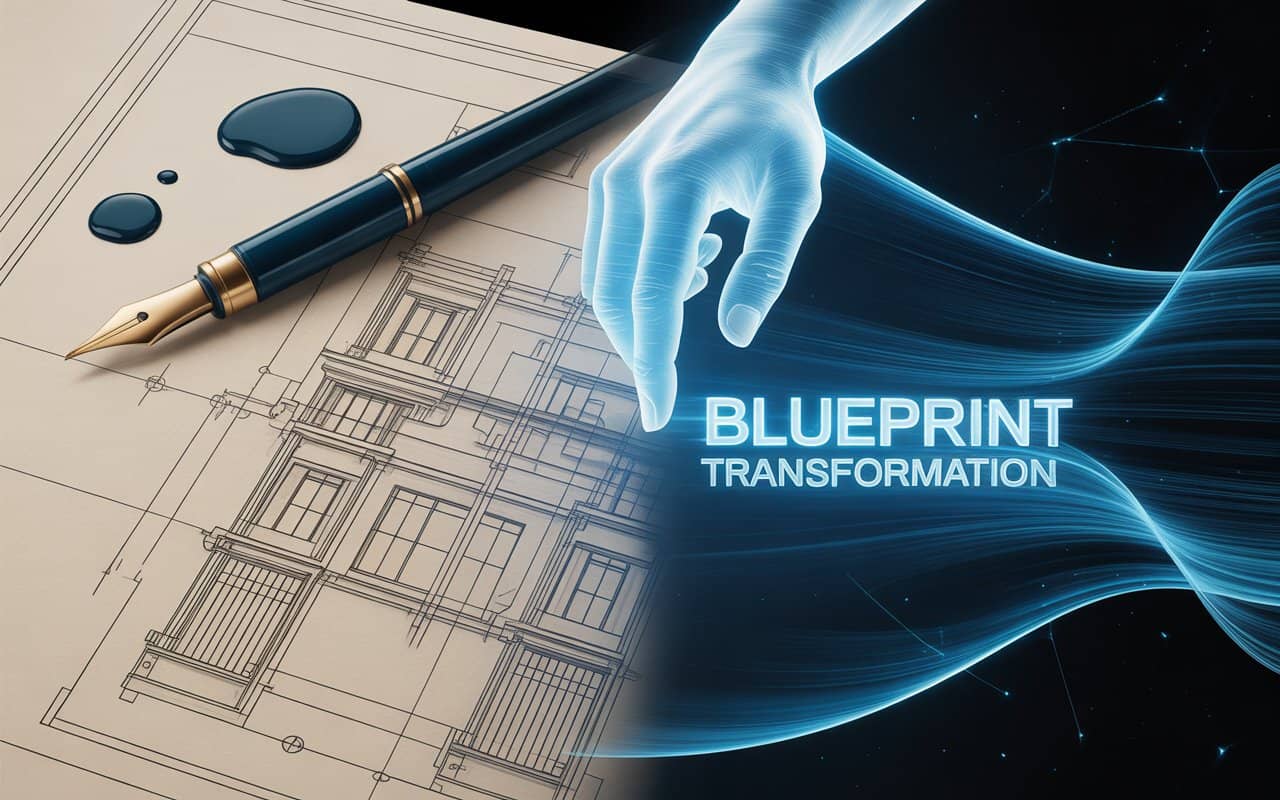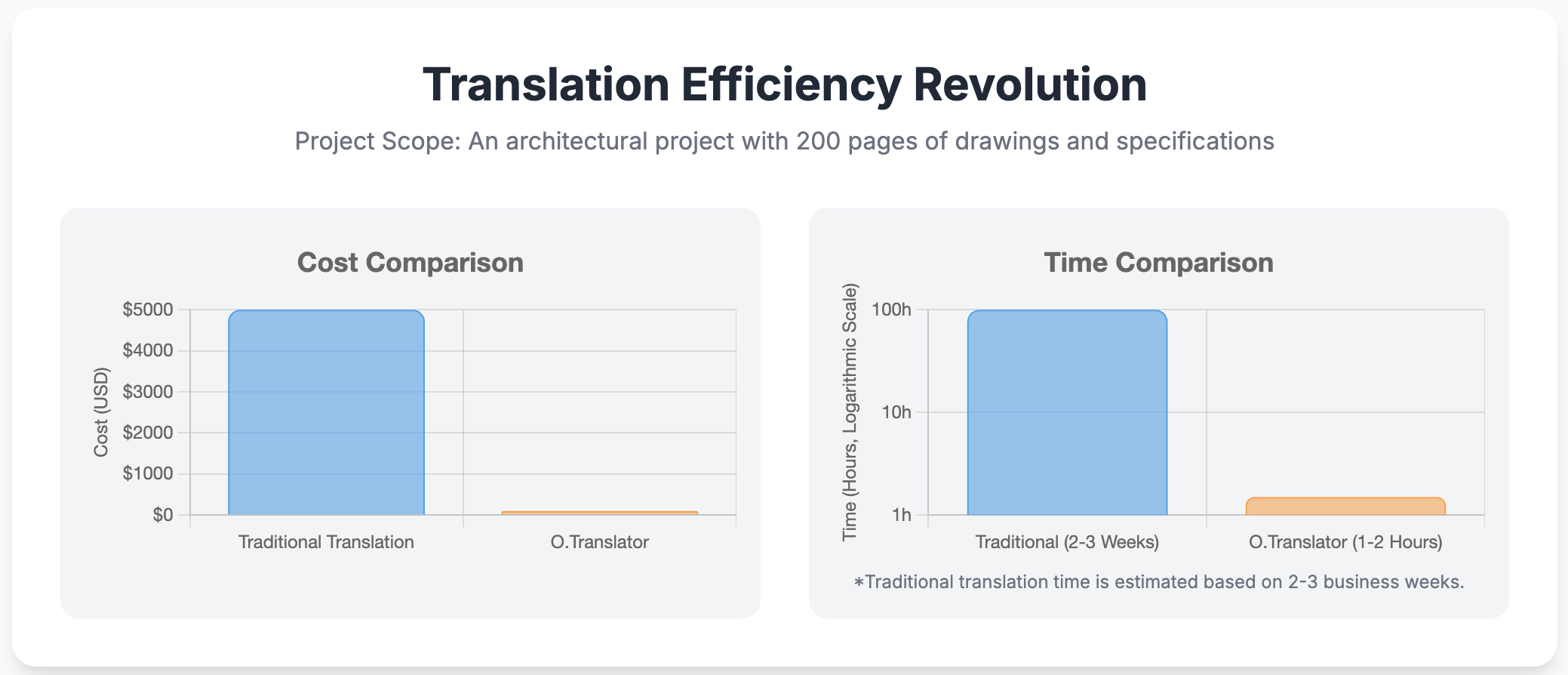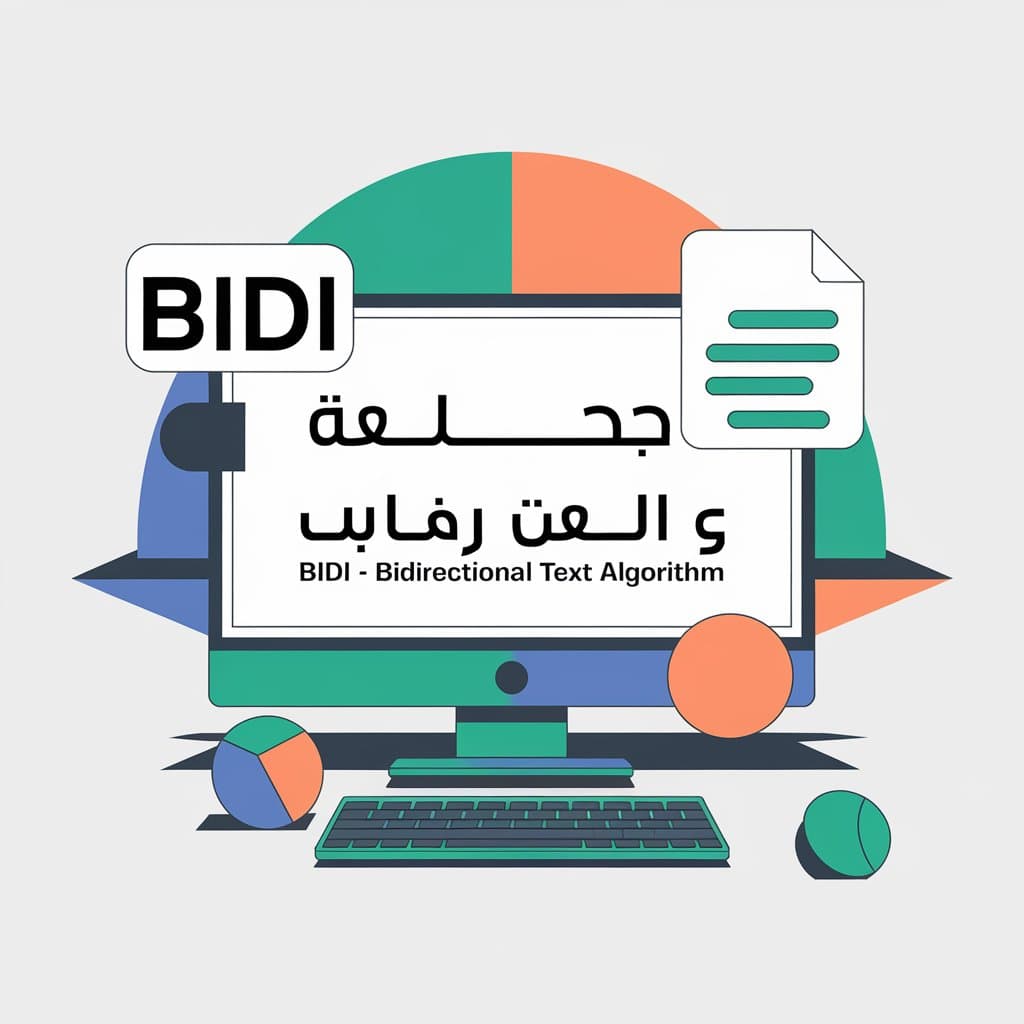2025 AI vs. Manual Architectural Drawing Translation Comparison
Loger
Sep 14, 2025

The Ultimate Showdown in Architectural Drawing Translation (2025): How O.Translator Is Disrupting Traditional Human Translation?
In international building projects, what are the consequences of mistranslated drawings or tender documents? At best, costly rework; at worst, millions in losses and irreparable project delays. For years, architects, engineers, and project managers have been forced to rely on traditional human translation agencies, trading substantial budgets for so-called 'professional assurance.'
But what if I told you that the rules of the game have changed? With breakthroughs in AI technology, O.Translator has emerged—offering even more reliable results at a fraction of the cost and at lightning speed.
If you’re struggling to choose the right translation solution, this article is your ultimate guide to making a smart, informed decision.
Quick Overview: Two Contenders at a Glance
- O.Translator (AI Innovator): An AI document translation platform dedicated to high-fidelity format preservation. Its unique edge is not a single AI model, but an integration of industry-leading engines such as GPT, Gemini, and Claude—purpose-built to tackle the most complex architectural document translation challenges with the unrivaled efficiency of AI.
- Traditional Human Translation (Industry Standard): A service model that relies heavily on human expertise. Projects are assigned by translation agencies, then manually translated and proofread by translators with industry backgrounds, before final desktop typesetting by DTP experts. It was once a byword for quality, but soon became synonymous with high costs and lengthy timelines.
Side-by-Side Comparison: Get the Full Picture in 60 Seconds
For busy professionals, this table enables you to instantly capture the core differences.
| Comparison Criteria | O.Translator (AI-driven) | Traditional Human Translation (Expert-Driven) | Winner |
|---|---|---|---|
| Format Fidelity | 🚀 Extremely High Efficiency: Instantly translates complex PDF, AI, and INDD files without conversion, automatically preserving vector graphics and layouts. | ⚠️ Manual Dependence: Requires expensive DTP (desktop publishing) services for manual re-layout, which is time-consuming and error-prone. | O.Translator |
| Technical Terminology | ✅ Reliable and Controlled: Maintains consistent terminology through customizable termbases, with robust AI contextual understanding. | 🏆 Outstanding: Human experts’ deep understanding of industry standards and subtle nuances remains the gold standard. | Traditional Human Translation (for subtleties) |
| Cost | 💰 Extremely Low: Pay-as-you-go pricing, with costs only a fraction of human translation (approximately $1 for every 20,000 words). | 💸 Expensive: Priced per character or page, with additional charges for project management, DTP, and more. | O.Translator |
| Delivery Efficiency | ⚡️ Minutes-Level: Upload large, complex drawings and receive results within minutes or hours. | 🐢 Days/Weeks: A complex project typically requires several days or even weeks to complete. | O.Translator |
| File Type Support | 🌐 Extensive Compatibility: Supports over 30 formats, including PDF, AI, INDD, DOCX, XLSX, and more, with a single file limit of up to 500MB. | 🔒 Limited: Typically accepts only mainstream formats and offers restricted capability for handling specialized source files. | O.Translator |
| Data Security | 🛡️ Flexible and Secure: SaaS version offers encrypted transmission and timed deletion; enterprise on-premises deployment keeps all data strictly within your internal network. | ❓ Uncertain: Security relies on the policies of translation agencies, with data transmitted via email between multiple parties, making risk difficult to control. | O.Translator |
Deep Dive: Details Decide Success or Failure
Round One: The Format Showdown – AI Automated Typesetting vs. Manual Desktop Publishing (DTP)
In architecture, format is content. If the dimensions, legends, or textual notes on a drawing are misplaced, it immediately loses all value.
- The traditional translation process is 'translate first, format later.'Translators work on the text in Word, after which DTP specialists manually copy and paste the translation back into the original InDesign or PDF files, much like piecing together a jigsaw puzzle. This process is not only labor-intensive and costly, but also highly susceptible to errors.
- O.Translator has fundamentally transformed this process. It leverages 'direct translation' technology to deeply analyze the underlying structure of documents. When you upload a complex PDF exported from CAD or a planning drawing in Adobe Illustrator format, O.Translator doesn’t simply extract the text. Instead, it translates directly while preserving the original layout, vector graphics, and layers. Interested in more details? This article, A Seamless Guide to Translating Adobe Illustrator Files, provides the answers.
Imagine the following scenario: A 100-page PDF tender, complete with detailed section drawings and construction details.
- Traditional approach: Translation requires 3 days, with an additional 5 days for DTP layout. The total turnaround exceeds a week, and DTP costs alone can reach several thousand dollars.
- O.Translator: Upload your file on Monday morning and receive a nearly perfectly formatted translation draft within half an hour, ready for immediate internal review.
Conclusion: On the most critical issue for architectural drawing translation—format fidelity—O.Translator claims an overwhelming victory, thanks to its advanced document parsing technology.
Round Two: Terminology Face-off – AI Terminology Database vs. Human Expert Memory
The architecture industry abounds with highly specialized terms, such as 'Shear Wall,' 'Curtain Wall,' and 'Floor Area Ratio.' Here, accuracy and consistency are everything.
- The strength of traditional translation lies in the expertise of seasoned professionals. An exceptional architectural translation specialist not only masters the language but also understands industry standards, allowing them to uncover hidden information within drawings.
- O.Translator leverages a cutting-edge AI engine with a customizable terminology database. Its advanced large language models (such as GPT-4o and Gemini) inherently possess robust contextual understanding capabilities. More importantly, it provides a custom glossary feature. Your team can batch upload your internal standardized terminology glossaries, compelling the AI to follow unified standards with 100% consistency in all translations. Want to know how? This “Unlocking Translation Consistency: Professional Glossary Usage Guide” is your essential manual.
Conclusion: In extreme cases that require creative interpretation of regulations, human experts remain irreplaceable. However, for 99% of technical documents, O.Translator’s integrated 'AI + glossary' solution already delivers highly accurate and fully consistent translations, perfectly avoiding stylistic and terminology discrepancies introduced by different translators.
Round Three: Efficiency and Cost – Delivery in Minutes vs. Weeks of Waiting
This is almost an uncontested matchup.
- Traditional translation is a labor-intensive industry, with cost and time serving as inherent bottlenecks. For medium-sized projects, quotes of several thousand dollars and weeks-long turnaround times are the norm.
- O.Translator showcases the exponential efficiency of AI. With its pay-as-you-go model (approximately $1/20,000 words), costs are slashed by over 90%, and delivery times are reduced from “days/weeks” to “minutes/hours.”

Conclusion: O.Translator’s cost and efficiency advantages are truly disruptive, transforming on-demand, instant bulk document translation from a luxury into a reality.
Round Four: Security Showdown – Data Closed Loop vs. Transmission Risk
Architectural drawings and commercial tenders are the lifeblood of any enterprise—data security can never be overemphasized.
- In the traditional translation process, your confidential documents are emailed to translation agencies, then distributed to various translators—many of whom are part-time. With numerous data transfer points, managing security becomes challenging and the risk of leaks is ever-present.
- O.Translator provides a layered security model, ensuring complete peace of mind.
- SaaS Platform: All files are securely transmitted with encryption and are automatically destroyed seven days after translation; you can also manually delete them at any time.
- Enterprise Edition (Ultimate Solution): For large architectural design institutes, government projects, and other clients with the highest security requirements, O.Translator offers a localized deployment solution. This means the entire translation service can be installed on your company's internal servers, ensuring all data processing occurs within your firewall and completely eliminating any risk of data leakage. This is a level of security assurance that traditional translation agencies and virtually all online translation tools simply cannot match.
Conclusion: With its unique enterprise-level localized deployment options, O.Translator offers organizations processing highly sensitive documents unrivaled security and control.
Real-World Scenario: Who Should You Choose?
-
If you're an agile architectural design firm... Regularly competing in international tenders and needing to respond rapidly and submit multilingual preliminary designs within days? **O.Translator is your go-to solution.**It empowers you to translate comprehensive tender documents into multiple languages within 24 hours, seamlessly preserving your meticulously crafted layouts—gaining you invaluable time in the bidding process.
-
If you're a project manager for a large-scale multinational architectural project... Needing to handle vast quantities of technical specifications, construction drawings, legal contracts, and progress reports every day? **O.Translator is your engine for efficiency.****With its low cost and high efficiency, it can handle 95% of your project’s documentation requirements. Combined with a robust terminology database, O.Translator ensures absolute consistency in communication across all subcontractors and team members.
-
If your documents are final, legally binding construction contracts... Do you require 100% legal and linguistic precision? **We recommend a hybrid “AI + Human” approach.****Start with O.Translator for a draft translation and formatting in just minutes, then engage a professional legal translator to provide the final review and refinement. This approach harnesses the efficiency of AI while ensuring the ultimate quality through expert human oversight—delivering the ideal solution for achieving the highest quality at optimal cost.
Final Recommendation: Embrace change rather than passively waiting.
Following a comprehensive comparison, the conclusion is unmistakably clear:
O.Translator is not simply a 'replacement' for traditional translation—it's a complete workflow upgrade.
For the architecture industry, the value of traditional human translation is shifting from 'end-to-end service' to 'final quality assurance.'When it comes to processing the vast majority of technical documents, drawings, and reports, O.Translator has established a decisive lead in format fidelity, cost, and efficiency. If you’re still struggling with disordered PDF formatting after translation, check out this “Quick Guide to Flawless PDF Translation.”
Our final recommendation is:
Integrate O.Translator into your workflow today, and let it handle 80–90% of your routine and technical document translations. Then, focus your valuable expert resources and budget on the final 10–20% of reviews that require in-depth legal or cultural interpretation.
This is not simply about choosing a new tool; it’s about adopting an entirely smarter, more efficient, and more competitive way of working. As the architectural industry is swept by the tide of digitalization, teams that are first to embrace this transformation will gain a decisive advantage in the intense arena of international competition.


